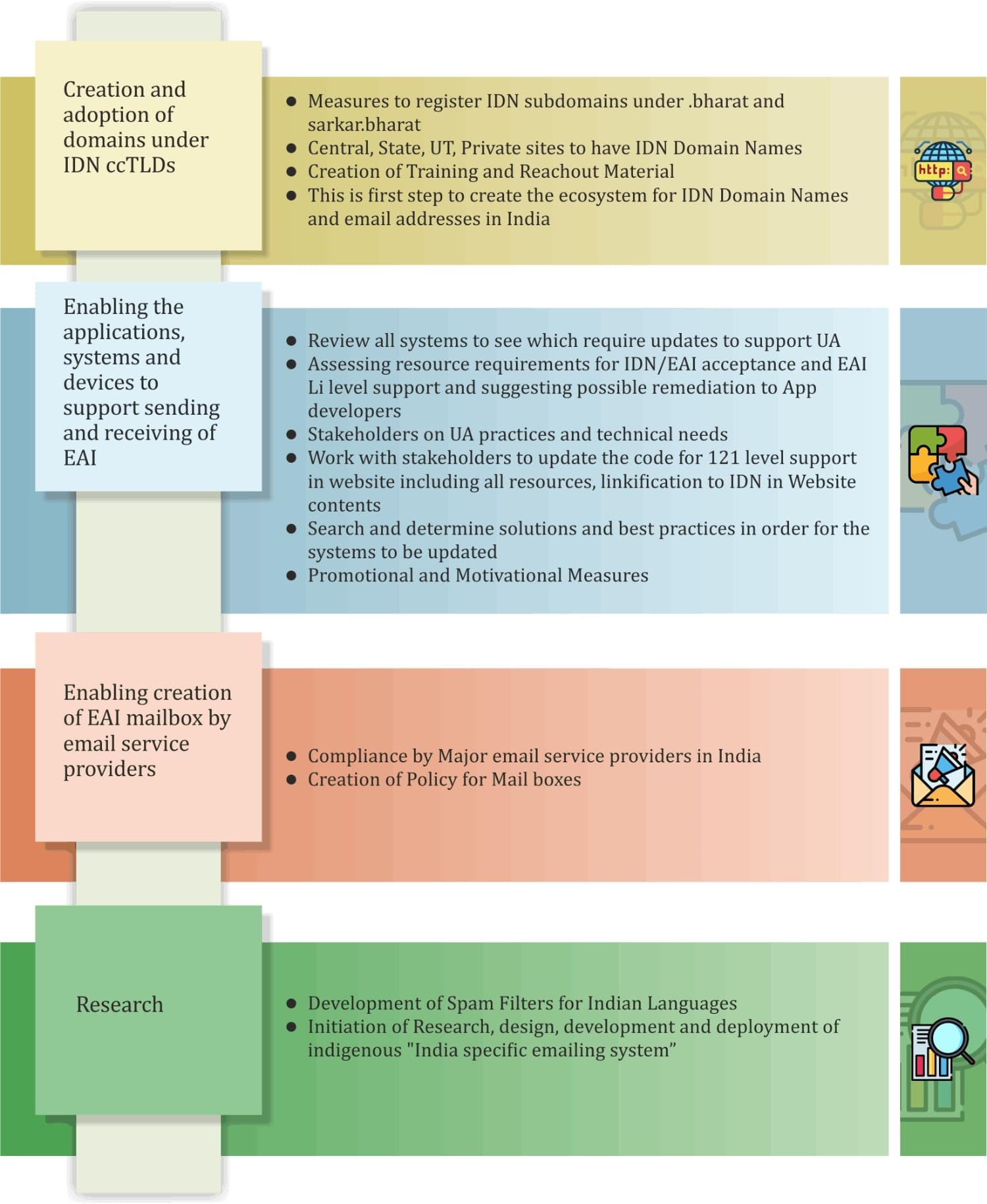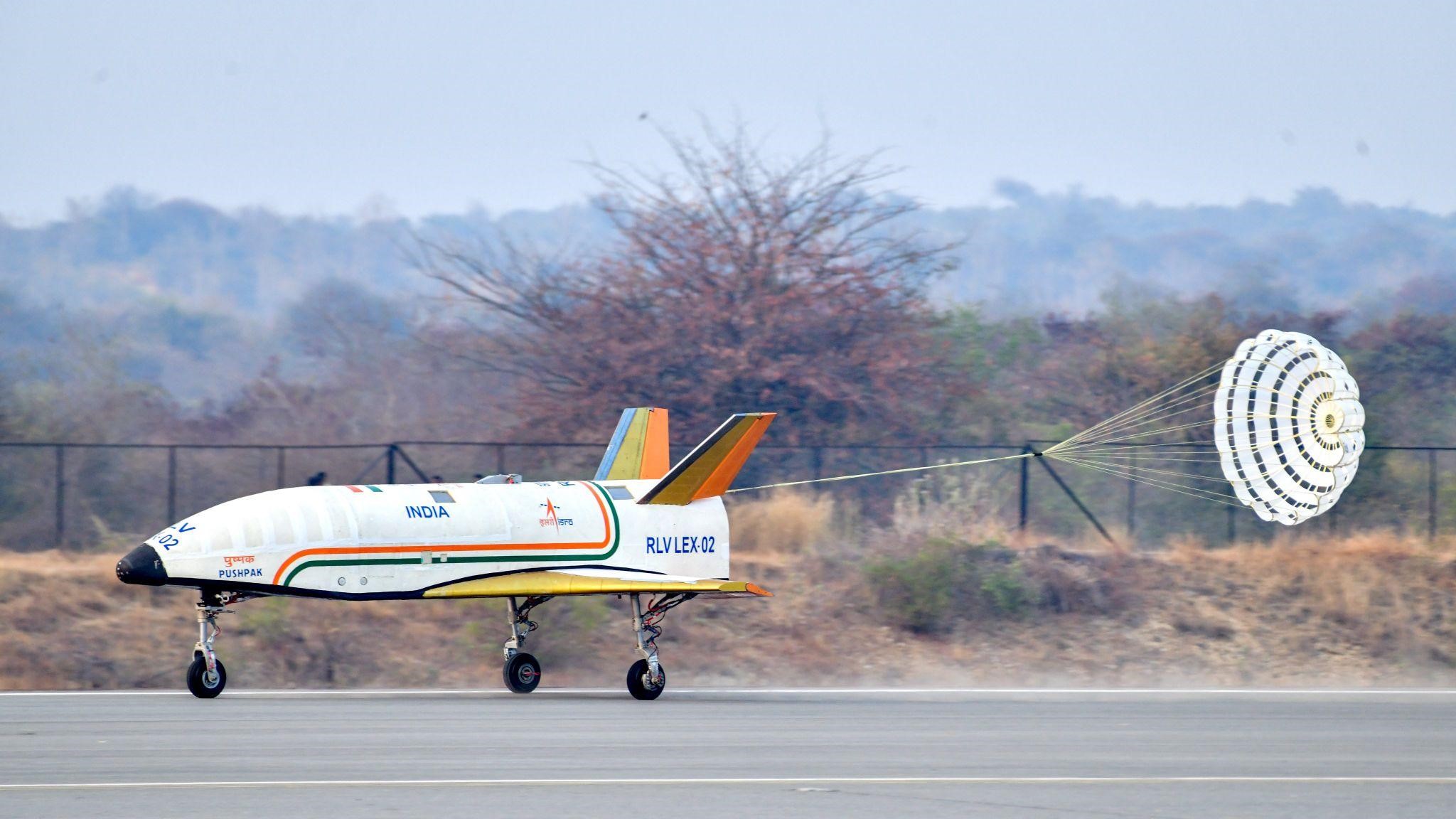Sansad TV and AIR Summary
March 4th Week
Bhasha Net portal
In news
The Ministry of Electronics and Information Technology (Meity) and the National Internet Exchange of India (NIXI) have launched the BhashaNet Portal on Universal Acceptance Day.
|
Universal Acceptance Day (UA Day)
●UA Day is celebrated every year on 28 March. It is celebrated to promote awareness and encourage UA adoption among stakeholders.
●It aims to create an inclusive Internet that supports a wide range of languages and scripts.
●The first event of UA Day was celebrated in 2023.
|

Copyright infringement is disclaimed
Theme: The theme of the event, "BhashaNet: Impetus Towards Universal Acceptance," highlighted MeitY/NIXI's unwavering commitment towards ensuring that, regardless of linguistic or textual barriers, everyone can fully participate in the digital world.
About BhashaNet portal
- The portal is designed to establish a multilingual internet environment, where website names and email addresses can be accessed in local languages.
- By catering to users in their native languages, the initiative promotes inclusivity and enhances accessibility.
- BhashaNet aims to create a multilingual internet where local language website names and email IDs work seamlessly everywhere.
Objective of BhashaNet Initiative
- Encouraging use of local language website name and email id.
- Promoting awareness of local language url and email id.
- Developing policies and regulations.
- Supporting technical collaboration.
- Engagement of Website owners, Web-Developer Community, Web Security experts.
Key features
UA Readiness Tools: Developers and businesses can access tools and guidelines to help them assess and improve the UA readiness of their applications and systems.
Multilingual Support: The portal will provide resources and information in multiple Indian languages, making it accessible to a wider audience.
Community Engagement: BhashaNet will foster a community of UA advocates, enabling knowledge sharing, collaboration, and support among stakeholders.
Best Practices and Case Studies: The portal will showcase best practices and case studies from organizations that have successfully implemented UA, serving as a source of inspiration and guidance for others.
Significance
- It aims to advance Universal Acceptance by furnishing developers, businesses, and organizations with resources, tools, and insights to ensure their applications and systems adhere to Universal Acceptance standards.
- This endeavour seeks to narrow the digital divide, ensuring universal access and benefit from digital services regardless of language or script barriers.
|
National Internet Exchange of India (NIXI)
●The National Internet Exchange of India (NIXI) is a non-profit organization that was established in 2003 under Section 8 of the Companies Act 2013 to facilitate improved internet services in the country.
●NIXI operates eight Internet Exchange Points (IXPs) across the country that enables peering among ISPs and content providers.
●NIXI allocates Internet Protocol (IP) addresses and Autonomous System (AS) numbers to Indian entities through its Indian Registry for Internet Names and Numbers (IRINN) division.
●NIXI-CSC Data Services Ltd. is a joint venture between NIXI and CSC e-Governance Services India Ltd. that provides data centre and cloud services to government and private sector customers.
|
About Universal Acceptance (UA)
- UA is a technical requirement that ensures all valid domain names and email addresses, regardless of script, language, or character length, can be equally used by all Internet-enabled applications, devices, and systems.
- The UA offers many benefits for both individual Internet users as well as the organizations that serve them.
- There are currently approximately five billion Internet users, and at least one billion more are expected to come online.
- Most of these potential new users live in countries that speak and write in languages other than English.
- Achieving UA ensures everybody has the ability to experience the full social and economic power of the Internet using their chosen domain name and email address that best aligns with their interests, business, culture, language, and script.
- UA is the gateway to a more inclusive and multilingual Internet.

Copyright infringement is disclaimed
Way forward
- Through the launch of the BhashaNet portal, the emphasis is to make all domain names and all email addresses work in all software applications.
- It provides an ecosystem to enable citizens to easily create, communicate, transact, process, and retrieve information with ease in digital mediums without a language barrier. It is taken up as part of the UA India programme which is a multistakeholder initiative to spread general UA awareness and to encourage UA adoption.
UN adopts first global AI resolution
In news
The UN General Assembly adopted a landmark resolution on the promotion of “safe, secure and trustworthy” artificial intelligence (AI) systems that will also benefit sustainable development for all.
|
The resolution, sponsored by the United States and co-sponsored by 123 countries, was adopted by consensus with a bang of the gavel and without a vote on Thursday, meaning it has the support of all 193 UN member nations.
|

Copyright infringement is disclaimed
Background
- Artificial intelligence (AI) and other frontier technologies hold significant potential for supporting inclusivity, reducing inequalities, rescuing the Sustainable Development Goals (SDGs) and bolstering the operations of the United Nations (UN) system.
- However, harnessing the positive impact of AI necessitates careful attention to its potential downsides, including by safeguarding data privacy, mitigating biases, and ensuring transparent decision-making processes.
- It is therefore important to make the most of AI’s opportunities while addressing risks and harms.
Objective
- The resolution encourages all countries, regional and international organizations, tech communities, civil society, the media, academia, research institutions and individuals “to develop and support regulatory and governance approaches and frameworks” for safe AI systems.
- It warns against “improper or malicious design, development, deployment and use of artificial intelligence systems, such as without adequate safeguards or in a manner inconsistent with international law.”
- A key goal, according to the resolution, is to use AI to help spur progress toward achieving the U.N.’s badly lagging development goals for 2030, including ending global hunger and poverty, improving health worldwide, ensuring quality secondary education for all children and achieving gender equality.
Global governance of AI
|
India
|
NITI Aayog has issued pivotal documents regarding AI, including the National Strategy for Artificial Intelligence and the Responsible AI for All report. These emphasize societal and economic inclusivity, innovation, and fostering trust.
|
|
China
|
China has implemented some of the world's initial nationally binding regulations targeting specific AI algorithms. Notably, it passed laws regulating recommendation algorithms, focusing on their information dissemination practices.
|
|
US
|
The US introduced a Blueprint for an AI Bill of Rights (AIBoR), addressing economic and civil rights concerns related to AI. This framework highlights five principles to mitigate potential harms. Unlike the EU's horizontal approach, the US adopts a sector-specific governance strategy, allowing federal agencies in sectors like health, labor, and education to devise their own plans.
|
|
European Union
|
In April 2021, the European Commission proposed the first EU regulatory framework for AI. It says that AI systems that can be used in different applications are analysed and classified according to the risk they pose to users. The different risk levels will mean more or less regulation.
|
|
United Kingdom
|
The UK advocates for a light-touch approach to AI governance, urging existing regulators in various sectors to apply relevant regulations. They've outlined five principles for companies to follow, encompassing safety, security, transparency, fairness, accountability, and redress.
The United Kingdom also hosted the first international AI Safety Summit Bletchley Park in November 2023.
The summit brought together around 100 politicians, academics and tech executives to plot a way forward for a technology that could transform the way companies, societies and economies operate.
|
Artificial Intelligence Revolution in India
- Artificial Intelligence (AI) is the key to driving commercial development for the world.
- Recent technological advancements, particularly in Industry 4.0, have transformed industries and businesses by integrating cloud computing, AI, analytics, and machine learning.
- In India, AI has shifted from being a marginal technology to a significant driver of business outcomes, with enterprises increasingly adopting it.
- According to the Principal Scientific Advisor (PSA) to the Government of India, AI expenditure in India surged by 109.6% or US$ 665 million in 2018.
- In addition, AI expenditure is estimated to surge at a compounded annual growth rate (CAGR) of 39% between 2019-25 to reach US$ 11,781 million by 2025.
|
According to a report published by the National Institute for Transforming India (NITI) Aayog in 2018, AI has the potential to add approximately US$ 957 billion or 15% of the current gross value to the country's economy in 2035.
|

Copyright infringement is disclaimed
Potential Impact of AI in India
The robust value proposition of technology is also one factor that rapidly increases the need for AI in India. AI can enhance outcomes in key sectors such as education, agriculture and healthcare.
Agriculture
AI holds the promise of driving a food revolution and meeting the increased demand for food (global need to produce 50% more food and cater to an additional 2 billion people by 2050 as compared to today).
- Crop Selection: AI-based solutions are ideal for crop selection as they can take complex parameters like soil type, monsoon dates, availability and affordability of ides, etc. into account along with historical data while choosing the crops.
- Crop Monitoring: Using technologies like IoT, drones, satellite imaging, etc. authentic data can be collected from the fields, monitored and analyzed by AI-based applications to identify the right solutions.
Healthcare
- Application of AI in healthcare can help address issues of high barriers to access to healthcare facilities, particularly in rural areas that suffer from poor connectivity and a limited supply of healthcare professionals. AI has the potential to transform the delivery of health services in rural areas, a challenge India has grappled with since Independence.
Education & Skilling
- Indian education has challenges like lack of teaching resources and individual attention, unequal access to educational opportunities, outdated pedagogies, etc.
Environment
- Air pollution, water pollution, sanitation, etc. are all contributors to environmental degradation and are the primary causes of widespread diseases impacting the livelihood in India.
National Security
- National security imperatives require that technology-based force multipliers be developed.
Way forward
- The UN global AI resolution recognizes the rapid acceleration of AI development and use and stresses “the urgency of achieving global consensus on safe, secure and trustworthy artificial intelligence systems.”
- It also recognizes that “the governance of artificial intelligence systems is an evolving area” that needs further discussions on possible governance approaches.
Guidelines for online betting and gambling platforms
In news
The information and broadcasting ministry (MIB) issued guideline for social media endorsers and influencers to refrain from promoting or advertising, including surrogate advertisements, offshore online betting and gambling platforms.
|
India has banned 138 offshore betting platforms last year. Later in the year, to curb illegal online gambling platforms, the Enforcement Directorate (ED) also attached ₹5.87 crore from several individuals and entities under the Prevention of Money Laundering Act, 2002.
|

Copyright infringement is disclaimed
Guideline and Directive
- The ministry strongly advises all endorsers and influencers on social media to refrain from showing such promotional content/advertisements, including surrogate advertisements, of offshore online betting and gambling platforms in any form.
- The ministry further advised the online advertisement intermediaries not to target such promotional content towards Indian audiences.
- The ministry cautioned that failure to comply may lead to proceedings under the provisions of the Consumer Protection Act, 2019, including removal or disabling of social media posts or accounts and penal action under the applicable statutes.
- The ministry said that such advertisements have significant financial and socio-economic implications for consumers, particularly the youth.
Waring and penal action
- The advisory cautions that failure to comply with it may lead to proceedings under the provisions of Consumer Protection Act, 2019 including removal or disabling of social media posts or accounts and penal action under the applicable statutes.
Earlier measures
- In 2020, the ad watchdog Advertising Standards Council of India (ASCI) issued guidelines for online gaming for real money winnings. The guidelines, which direct online gaming platforms to carry disclaimers about the risks associated with real-money games, came into effect from December 2023.
- Subsequently, TV broadcasters were asked to comply with the ASCI guidelines. In 2022, the MIB issued an advisory asking TV, print, and digital media platforms to refrain from airing or publishing online betting ads.
Games and Legislation
|
Casino games
|
Casino games are regulated by state-level laws in India and their digital forms also fall within the ambit of the same laws. Casino games are games of chance and hence are hit by the prohibitions of most state-level anti-gambling laws (“State Gaming Laws”). However, the state of Sikkim permits the offering of casino games such as roulette and blackjack by obtaining a licence under the provisions of the Sikkim Online Gaming (Regulation) Act, 2008 (“Sikkim Act”) and on the condition that the games can only be offered via intranet terminals.
The authority under the Sikkim Act is the Finance, Revenue and Expenditure Department.
|
|
Betting
|
If the betting is on games of chance, then it would attract the prohibitions under the State Gaming Laws. If it is on casino games, please refer to the corresponding row above. For sports betting and fantasy sports, please refer to their respective rows below.
|
|
Lotteries
|
Lotteries have been expressly excluded from the purview of the State Gaming Laws and are regulated by central laws and certain state-level lottery laws (collectively, “Lottery Laws”). Private lotteries, except those permitted under a duly granted licence by the state government, are banned under the Indian Penal Code, 1860 (“IPC”).
|
|
Skill games and competitions with no element of chance
|
There are specific exemptions for games of skill under most State Gaming Laws and courts have also recognised offering of skill games as a legitimate business activity that is constitutionally protected. No licence is required for offering skill games in most states in India except Sikkim and Nagaland, which have licensing regimes for skill games under the respective Acts.
|
Clinical trials of Tuberculosis vaccine MTBVAC in India
In News
In a major milestone towards having a vaccine for tuberculosis, the Hyderabad-based vaccine maker Bharat Biotech has started clinical trials of tuberculosis vaccine candidate MTBVAC in India.
|
MTBVAC is a Spanish tuberculosis vaccine, the first live attenuated vaccine of Mycobacterium tuberculosis isolated from a human.
MTBVAC's development is a global public-private partnership. The European Union, American institutions like the International AIDS Vaccine Initiative (IAVI), and the National Institutes of Health have all played a role in funding and conducting various stages of the trials.
|

Copyright infringement is disclaimed
About
The MTBVAC is being developed for two purposes; firstly, as a more effective and potentially longer-lasting vaccine than BCG (Bacillus Calmette Guérin) for newborns and secondly, for the prevention of TB in adults and adolescents, for whom there is currently no effective vaccine.
The trials are carried out by Bharat Biotech in close collaboration with Biofabri.
Trials to evaluate the safety and immunogenicity of MTBVAC have started with a pivotal safety, immunogenicity and efficacy trial planned to start in 2025.

Copyright infringement is disclaimed
Clinical trial and global stage
- The first is that after the recent completion of a Phase2 dose finding trial, a double-blind, controlled Phase3 clinical trial in newborns has started in 2023, comparing the vaccine with the current BCG vaccine. 7,000 newborns from South Africa, 60 from Madagascar and 60 from Senegal will be vaccinated.
- The aim is to assess the immunogenicity and efficacy of MTBVAC which is administered intradermally to infants on the first day of life.
- According to Bharat Biotech, another important milestone is that after completing a dose escalation trial in HIV uninfected adults, a Phase2 study in HIV infected adults has started in 2024 to determine whether MTBVAC is safe in this population.
- This ongoing trial at 16 sites in South Africa – involving the vaccination of 276 adults – is evaluating safety and immunogenicity in HIV-negative and HIV-positive adults and adolescents vaccinated with MTBVAC.
About Tuberculosis
- Tuberculosis (TB) is an infectious disease that most often affects the lungs and is caused by a type of bacteria.
- It spreads through the air when infected people cough, sneeze or spit.
- About a quarter of the global population is estimated to have been infected with TB bacteria. About 5–10% of people infected with TB will eventually get symptoms and develop TB disease.
- People with latent TB infection don’t feel sick and aren’t contagious.
- Babies and children are at higher risk.
- TB disease is usually treated with antibiotics and can be fatal without treatment.

Copyright infringement is disclaimed
Current Vaccine for TB
- The only related vaccine in use today, BCG (Bacillus, Calmette and Guérin), is an attenuated variant of the bovine TB pathogen.
- It is at least 100 years old and has a limited effect on pulmonary tuberculosis, which is responsible for the transmission of the disease.
Global cases of Tuberculosis
- A total of 1.3 million people died from TB in 2022 (including 167 000 people with HIV). Worldwide, TB is the second leading infectious killer after COVID-19 (above HIV and AIDS).
- In 2022, an estimated 10.6 million people fell ill with tuberculosis (TB) worldwide, including 5.8 million men, 3.5 million women and 1.3 million children.
- TB is present in all countries and age groups. TB is curable and preventable.
- Multidrug-resistant TB (MDR-TB) remains a public health crisis and a health security threat. Only about 2 in 5 people with drug resistant TB accessed treatment in 2022.
- Global efforts to combat TB have saved an estimated 75 million lives since the year 2000.
- US$ 13 billion is needed annually for TB prevention, diagnosis, treatment and care to achieve the global target agreed at the 2018 UN high level-meeting on TB.
- Ending the TB epidemic by 2030 is among the health targets of the United Nations Sustainable Development Goals (SDGs).

Copyright infringement is disclaimed
Reusable Launch Vehicle ‘Pushpak’
In news
The Indian Space Research Organization successfully conducted the second landing test of its reusable launch vehicle (RLV), Pushpak, from the Aeronautical Test Range (ATR) in Challakere near Chitradurga in Karnataka.
|
Pushpak is ISRO’s second series of RLV landing experiment and this time, the RLV exhibited autonomous landing capability and undertook more difficult manoeuvres with dispersions.
The Pushpak RLV is designed as an all-rocket, fully reusable single-stage-to-orbit (SSTO) vehicle, incorporating several major elements such as the X-33 advanced technology demonstrator, the X-34 testbed technology demonstrator, and the upgraded DC-XA flight demonstrator.
|

Copyright infringement is disclaimed
Background
- ISRO had successfully conducted previous RLV missions in 2016.
- In April, 2023 ISRO successfully conducted the series of experiments with RLV-TD.
- It was part of efforts at “developing essential technologies for a fully reusable launch vehicle to enable low-cost access to space”.
- ISRO’s RLV-TD looking like an aircraft consisted of a fuselage, a nose cap, double delta wings, and twin vertical tails.
- This mission is a part of ISRO's ongoing efforts to develop essential technologies for a fully reusable launch vehicle, aimed at enabling low-cost access to space.
RLV-LEX-02 Experiment
- The RLV-LEX-02 (Pushpak) showcased the autonomous landing capabilities of the Reusable Launch Vehicle (RLV) from non-standard initial conditions upon release from the helicopter.
- The winged vehicle underwent more challenging maneuvers, correcting both cross-range and downrange dispersions to land autonomously on the runway.
- An Indian Air Force helicopter lifted lifted Pushpak to an altitude of 4.5 km before release.
Significance
- This mission simulated the high-speed landing scenarios of an RLV returning from space, validating crucial technologies in navigation, control systems, landing gear, and deceleration systems.
- The successful reuse of flight hardware and systems from RLV-LEX-01 underscored ISRO’s capability in developing indigenous technologies for space missions.
About RLV-TD (technology demonstrator)
- The Reusable Launch Vehicle–Technology Demonstration Programme (RLV-TD) initiated by the Indian Space Research Organisation (ISRO) aims to develop and demonstrate technologies for a Two Stage to Orbit (TSTO) reusable launch vehicle, with the second stage envisioned as a spaceplane.
- RLV-TD (technology demonstrator) is one of the most challenging endeavours of the Indian space agency towards developing essential technologies for a fully reusable launch vehicle to enable low-cost access to space.
- The configuration of RLV-TD is similar to that of an aircraft and combines the complexity of both launch vehicles and aircraft.
- The winged RLV-TD has been configured to act as a flying test bed to evaluate various technologies, including hypersonic flight, autonomous landing and powered cruise flight.
Key Experiments under RLV-TD
|
Hypersonic Flight Experiment (HEX)
|
Objective: The first test flight conducted on 23 May 2016 aimed to validate various aspects of the vehicle's design during hypersonic flight, including aerodynamic characteristics, induced loads, and the performance of structural materials.
Technological Focus: Tested the aerodynamic design characteristics and induced loads during hypersonic descent, assessed the performance of carbon fiber construction in the nose section, and demonstrated first-stage separation sequencing.
Outcome: The vehicle was tracked throughout the flight from ground stations and a shipborne terminal. Critical technologies such as autonomous navigation, guidance & control, and reusable thermal protection system were validated.
|
|
Landing Experiment (LEX)
|
RLV-LEX-01
Objective: Conducted on 2 April 2023, this experiment simulated the conditions of a space re-entry vehicle's landing to validate landing parameters and precision landing capabilities.
Execution: The vehicle was released mid-air from a downrange distance of 4.6 km and successfully landed at the Chitradurga Aeronautical Test Range.
Outcome: Successfully validated landing parameters including ground relative velocity, sinking rate of landing gears, and precise body rates.
RLV-LEX-02
Objective: Conducted on 22 March 2024, this experiment focused on autonomous precision landing after release from an off-nominal position.
Execution: The vehicle was released from an altitude of 4.5 km and had to correct cross-range and down-range deviations before autonomously landing on the runway.
Outcome: Demonstrated the capability of the vehicle to autonomously correct deviations and execute a precise landing using its nosewheel steering system, landing gear brakes, and drogue parachute.
|
Way forward
- This mission successfully simulated the approach and high-speed landing conditions of RLV returning from space.
- With this second mission, ISRO has re-validated the indigenously developed technologies in the areas of navigation, control systems, landing gear and deceleration systems essential for performing a high-speed autonomous landing of a space-returning vehicle.
- This experiment marked the third flight of Pushpak, part of a series of tests aimed at refining its robotic landing capabilities under more complex conditions.
- In the coming years, this vehicle will be scaled up to become the first stage of India’s reusable two stage orbital launch vehicle.













